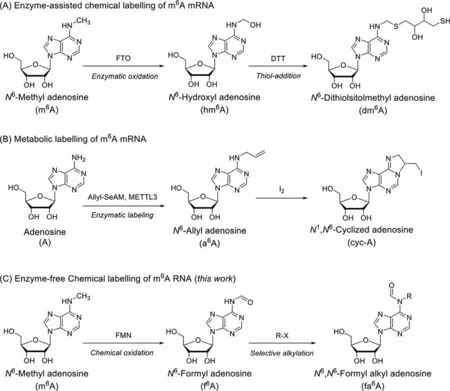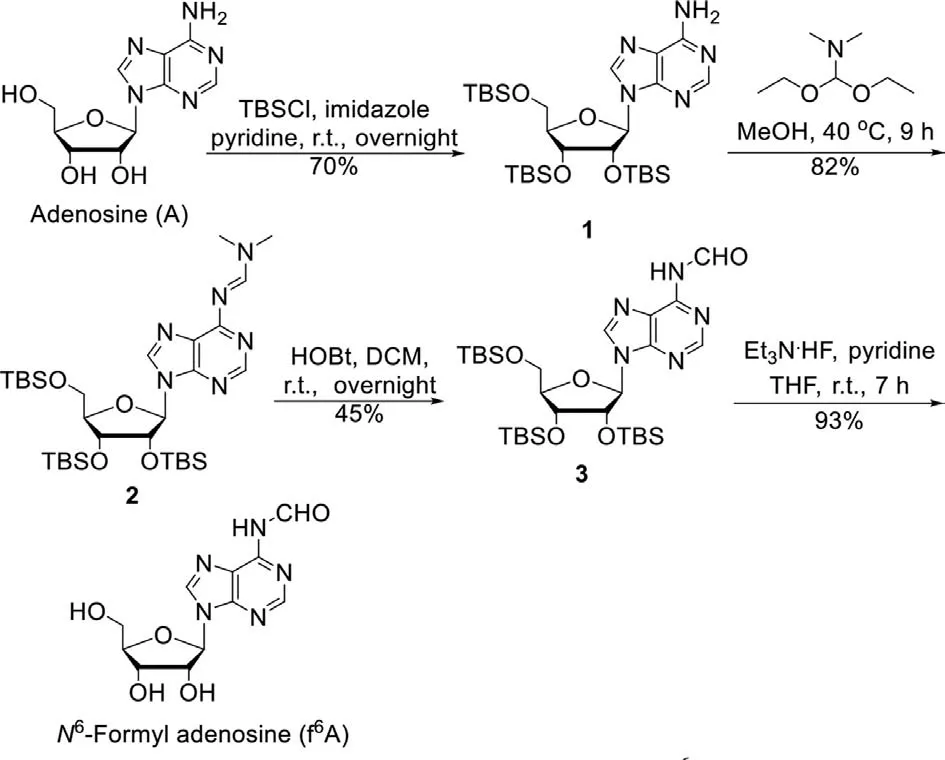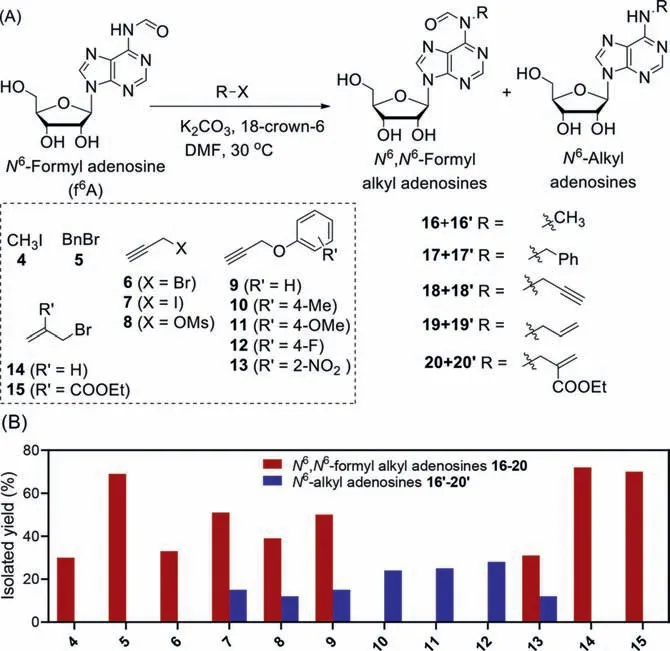A chemical labeling of N6-formyl adenosine (f6A) RNA
Li-Jun Xie,Cui-Lin Lin,b,Li Liu,b,Ling Cheng,b,∗
a Beijing National Laboratory for Molecular Sciences (BNLMS),CAS Key Laboratory of Molecular Recognition and Function,CAS Research/Education Center for Excellence in Molecular Sciences,Institute of Chemistry,Chinese Academy of Sciences,Beijing 100190,China
b University of Chinese Academy of Sciences,Beijing 100049,China
Keywords:RNA epigenetics Chemical modulation Labeling Nucleic acids Alkylation
ABSTRACT N6-methyl adenosine (m6A) is an eminent epigenetic mark in mRNAs that affects a broad range of biological functions in diverse species.However,the chemically inert methyl group prevents a direct labeling of this modification for subsequent detection and sequencing.Therefore,most current approaches for the labeling of m6A still have limitations of relying on the utilization of corresponding methyltransferases,which resulted in the lacking of efficiency.Here we present an approach which selectively alkylated the N6-formyl adenosine (f6A),the key intermediate during chemical oxidation of m6A,with an alkyne functionality that can be further labeled with click reactions.This covalent labeling approach will be able to facilitate in the affinity purification,detection and genome-wide profiling studies.
N6-Methyl adenosine (m6A) is a widely studied epigenetic mark that was discovered in the early 1970s in messenger RNAs (mRNAs)from eukaryotes [1–4].The methylation process is catalyzed by a multicomponent methyltransferase complex,including METTL3,METTL14,WTAP and other “writers” [5,6].FTO and ALKBH5 are so-far two identified m6A demethylases (“erasers”) that can remove m6A methylated groups from RNA,which makes the epigenetic modification a dynamic reversible process [7–9].On the other hand,regulatory proteins (“readers”) like YTHDF and YTHDC subtypes can bind to the m6A modification site in RNA and initiate different downstream effects [10–12].However,the comprehensive biological functions of m6A modification are not fully understood at present [13,14],largely because of the difficulties of identifying m6A sites.TheN6-methyl substituent does not affect its reverse transcription during the PCR process.Therefore,traditional m6A RNA fragments are usually captured and enriched by immunoprecipitation and then identified by second-generation sequencing[15–19].However,these approaches are limited to the sources of antibodies or recognizing enzymes (reading proteins or restriction enzymes) and the specific sites in the transcriptome.Thus,there is a great need for a simple,sensitive,antibody-free method for m6A detection.
Labeling of nucleic acids is required for many studies aiming to elucidate their functions and dynamicsin vitroand in live cells.To date,two different strategies have been developed to label,profile and analysis genome-wide m6A methylation patterns in live cells (Scheme 1).Jiaet al.utilized m6A demethylease FTO that are responsible to m6A demethylation at the RRm6ACH sequence and converted the inert methyl substituent to chemically reactive hydroxymethyl group (hm6A),which was sensitive to nucleophilic substitution with thiol compounds like dithiothreitol (DTT)to afford theN6-dithiolsitolmethyl adenosine (dm6A) [20].Thus,bioorthgonally functional groups like alkyne/azide containing thiols can be exploited to collect those fragments and then subjected to library construction and deep-sequencing (Scheme 1A).Similarly,Liuet al.adapted the enzymatic methylation process by replacing the natural methyl donor SAM to Se-allyl-L-selenohomocysteine(Ally-SeAM) [21].Under the promotion of the methyltransferase METTL3,the original m6A sites will be replaced withN6-allyl adenosines (a6A).With the chemically functional alkenyl substituent in hand,they initiated the iodine-catalyzed intramolecular cyclization to generate theN1,N6-cyclized adenosine (cyc-A)followed by sequencing (Scheme 1B).In spite of above two methods,further technology development of a robust,efficient,unbiased approach for whole-genome methylation profiling of m6A is still highly desirable.The development of such an approach without using antibodies or modifying enzymes will aid the general community in consistent profiling of RNA epigenetic modifications,and in developing disease-specific diagnoses as well as establishing biomarkers.

Scheme 1.Previously reported labeling of m6A and our strategy.
Here we propose a new approach inspired by the discovery that m6A can be chemically oxidized by the flavin mononucleotide(FMN) promoted oxidation [22].The inert C–H bonds at theN6-methyl sites can be selective activated to generate hm6A,just like FTO enzyme.On the other hand,hm6A can be further converted toN6-formyl adenosine (f6A).We and others have invented chemical-labeling approaches to selectively label C5-formyl cytidines (f5C/5fC) with functional groups,such as amines,for robust affinity enrichment,determination and sequencing [23–27].We envisioned that such a chemical labeling strategy could be combined with FMN-mediated conversion of m6A to f6A for a selective labeling of m6A for genome-wide detection and profiling (Scheme 1C).In our new approach,we took advantage of the electron-withdrawing propriety of the formyl group by employing the nucleophilic substitution.Utilizing Huisgen cycloaddition(click) chemistry [28],a possible tag (or any chemical tag) may be installed,thus facilitating an efficient and unbiased labeling of the original m6A-containing RNA fragments for detection and genomewide profiling.This new approach may provide a wider coverage of m6A-containing genomic regions compared with other affinityenrichment methods.
To investigate the reactivity of f6A,we firstly prepared the adenosine derivative in a gram scale (Scheme 2) [8].The hydroxyls at adenosine were protected withtert–butyl(dimethyl)silyl(TBS) group,and then the free amine in 1 was reacted withN,Ndimethyformamide diethy acetal to generate the dimethylformimidamide 2.The latter was then subjected to hydrolysis with hydroxybenzotriazole to release theN-formyl group.We modified this step by using dichloromethane instead of methanol,which significantly improved the yield to 45%.Upon treatment with triethylamine trihydrofluoride,the unprotected f6A was obtained in 23%yield (4 steps).

Scheme 2.Synthesis of f6A.
With the sufficient amount of f6A in hand,we then investigated the chemical labeling of this central intermediate (Scheme 3A).We firstly intended to functionalize the carbonyl group with Wittig olefination,nucleophilic addition and other related reactions.However,due to the amide resonance with its enolate isomer,the carbonyl was stabilized in theN-formyl functionality and thus cannot be labeled under extreme mild conditions (see Supporting information for details).We thus tuned to theN-formyl itself by adapting theN-alkylation of peptides/proteins.The N–H in f6A was influenced by the heterocyclic adenine and the attached carbonyl group and should be acidic enough to be easily deprotonated.Thus by using mild potassium carbonate as the base with the crown ether 18-crown-6,we were able to screen a bunch of electrophiles,in most cases,alkyl halides 4–15.With the simplest iodomethane 4,theN6-formyl-N6-methyl adenosine 16 was obtained in a 30% yield with 3 h (Scheme 3B,Table S1 in Supporting information).However,no de-formylation product 16′was observed,indicating that the alkylation indeed could selectively label f6A while inhibiting its hydrolysis.A much more reactive benzyl bromide 5 would lead to a higher yield of the corresponding di-substituted adenosine in 40 min.Considering the bioorthgonal property of alkyne functionality,we next tested several alkynyl halides 6 and 7 and sulfonates 8–13.While the propargyl chloride 6 afforded theN6-formyl-N6-propargyl adenosine 18 in a 33% yield,its bromide analogue 7 resulted in a much faster alkylation (within 15 min) along with a few de-formylation product 18′(15%).We thus assume that the leaving group might play a crucial role in the efficiency of the propargylation and may influence the stability of the product 18 during the alkylation.Indeed,simple propargyl mesylate 8 and benzenesulfonate 9 generated uneven distribution of 18 and 18′.Interestingly,thep-toluenesulfonate 10,p-methoxyl benzenesulfonate 11 andpfluorobenzenesulfonate 12,all afforded theN6-propargyl adenosine 18′in inferior yields (24%−28%),while theo-nitro benzenesulfonate 13 delivered moderate amount of 18 (31%).We also verified if allylic motif can be introduced to f6A since the terminal alkene is also a bioorthgonal handler in biocongugation chemistry.Thus f6A was subjected to react with allylic bromide 14,affording the corresponding labeled product 19 in good yield (72%) without any noticeable de-formylation.Another interesting example was using Morita-Baylis-Hillman adduct 15 as the electrophile.In that case,the acrylate motif was selectively introduced to theN6-position,which might afford another type of chemical enrichment by conjugate addition.Thus different labeling groups could be hosted by varying the electrophiles.

Scheme 3.Chemical Labeling of f6A.

Scheme 4.The click reaction of 18 with ethyl azidoacetate.
As a demonstration of the utilization of this powerful reaction toward m6A enrichment,we applied the 1,3-dipolar cycloaddition of the product 18 with ethyl azidoacetate 21 (Scheme 4).The click reaction smoothly afforded the triazole product 22 in good yield (45%).Interestingly,the formyl group was removed during the post-modification process.In a word,we have developed a wide range of labeling intermediates with f6Aviasimple steps and rapidly creating new products for further applications.

Scheme 5.(A) The preparation of f6A RNA;(B) HPLC analysis of an ssRNA 5′-AUUCUCAm6AC-3′ after treatment with FMN and irradiation with blue LED light of 470 nm under oxygen for 30 min (red line),compared to A RNA (5′-AUUCUCAAC-3′)and m6A RNA (blue line);(C) Stability test of f6A RNA (red line) at room temperature and the generation curve of A RNA (black line).
In order to explore the possibility of this approach at transcription RNAs,we prepared an m6A containing oligo 5′-AUUCUCAm6AC-3′ and subjected it to the standard chemical demethylation conditions (Scheme 5A).We have carefully optimized the amount of FMN and the oxidation time.Finally we were able to generate the f6A oligo 5′-AUUCUCAf6AC-3′ in 36% yield according to HPLC analysis (Scheme 5B).It was reported in literature that f6A was unstable in aqueous solutions and rapidly hydrolysed to adenosine.However,under our reaction conditions,f6A oligo was stable in 8 h,with less than 30% of decomposition(Scheme 5C).With that in hand,we applied the aforementioned labeling to this oligo (see Supporting information for details).Unfortunately,the f6A oligo remained untouched or decomposed completely under these conditions (pH 8.0 or pH 9.0),no matter what electrophile we have used.Thus,a more efficient method would be needed for RNA samples isolated from live cells.This optimization is currently underway in our laboratory and will be reported in due courses.
In summary,we have presented a practical approach for the selective labeling of f6A,an essential intermediate during the oxidative demethylation of m6A,with simple and easily available small organic molecules.The alkylation proceeded rapidly and selectively under mild conditions to covalently link a bunch of bioorthogonal components.With the successful establishment of click reaction pertaining to f6A derivatives,it is expected to provide a useful strategy for chemically uniform and highly selective labeling of m6A RNAs in an enzyme-free and covalent selective fashion.
Declaration of competing interest
The authors declare no conflict of interest.
Acknowledgments
This work was supported by the National Key R&D Program of China (Nos.2017YFA0208100 and 2020YFA0707901),National Natural Science Foundation of China (Nos.22022704,91853124,21977097 and 21778057),Postdoctoral Innovative Talents Support Program (No.BX20200337,to Dr.L.-J.Xie) and Chinese Academy of Sciences.
Supplementary materials
Supplementary material associated with this article can be found,in the online version,at doi:10.1016/j.cclet.2021.09.028.
 Chinese Chemical Letters2022年3期
Chinese Chemical Letters2022年3期
- Chinese Chemical Letters的其它文章
- Direct catalytic nitrogen oxide removal using thermal,electrical or solar energy
- Construction and applications of DNA-based nanomaterials in cancer therapy
- Recent research progress of bimetallic phosphides-based nanomaterials as cocatalyst for photocatalytic hydrogen evolution
- Nanostructured materials with localized surface plasmon resonance for photocatalysis
- Recent progress of Pd/zeolite as passive NOx adsorber: Adsorption chemistry,structure-performance relationships,challenges and prospects
- Microfluidic methods for cell separation and subsequent analysis
